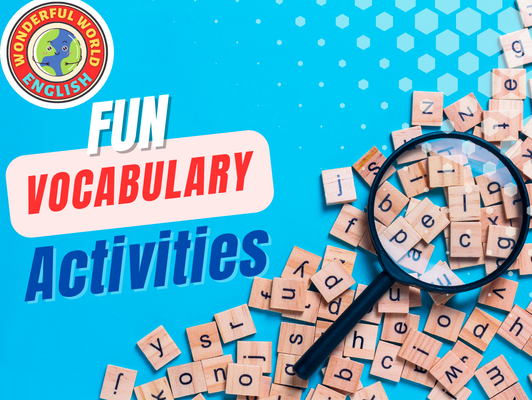Contents
Toggle
Meet David De’ Ath, founder, editor, and writer at Wonderful World English. With his extensive background as an English teacher, David provides valuable insights and practical tips on ESL for students and teachers alike.
Engaging students in the development of their vocabulary can be a challenging endeavor.
Traditional methods like memorization may not always resonate with every learner.
However, by integrating fun vocabulary activities into the learning process, educators can enhance students’ engagement and help them make meaningful connections with the words they’re learning.
Activities that are both enjoyable and educational can transform vocabulary learning from a tedious task into an exciting adventure that students look forward to.
To effectively expand a student’s lexicon, an array of activities that cater to different learning styles can be employed.
Vocabulary games, interactive strategies, and creative learning tools introduce new words and reinforce their meanings and usage in various contexts.
The goal of these activities is not just to broaden students’ word banks but also to deepen their understanding and ability to apply vocabulary in real-life situations.
Through the deliberate use of these methods, vocabulary acquisition becomes a dynamic aspect of everyday classroom activities, promoting better communication skills across all subject areas.
Key Takeaways
- Variety in vocabulary activities boosts engagement and understanding.
- Games and interactive strategies support diverse learning styles.
- Continuous application of vocabulary enhances real-world communication skills.
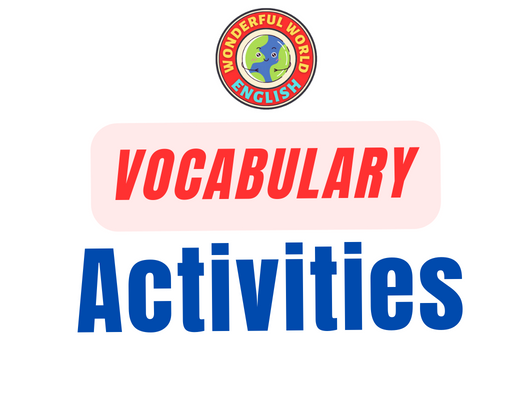
Foundations of Vocabulary Activities
Students’ success in developing vocabulary skills hinges on systematic instruction and engaging activities.
This section explores the foundations that are integral for learning and boosting student confidence in vocabulary mastery.
Understanding Vocabulary Instruction
Vocabulary instruction goes beyond mere memorization of word meanings.
Effective vocabulary teaching involves strategies that encourage deep understanding and usage of words in various contexts.
Such instruction offers students the essential tools to interpret and convey nuanced meanings, leading to more precise and powerful communication.
Activities are designed to expand a student’s lexicon and enhance their ability to apply vocabulary knowledge practically.
Educators must select activities that facilitate repeated exposure to new words across different settings.
This reinforces word learning and helps integrate new vocabulary into a student’s active language repertoire.
For example, having students use new words in original short stories or discussions can solidify their understanding and retention.
For some insights into how to teach vocabulary to students, the guide below has you covered!
Related: How to Teach Vocabulary to ESL Students: Teacher’s Guide
Key Principles of Engaging Vocabulary Activities
When curating vocabulary activities, engagement, and interactivity are key principles.
Activities that encourage active participation will lead to higher levels of student engagement and, ultimately, greater learning outcomes.
- Success in vocabulary activities can be achieved when students are:
- Involved in collaborative tasks that require communication and peer interaction.
- Challenged with creative and context-rich exercises like writing prompts or role-playing scenarios.
- For confidence to be bolstered in students, activities should:
- Provide immediate positive feedback to affirm correct usage.
- Offer varying levels of difficulty to cater to diverse learning abilities.
Educators must thread these principles into the fabric of their vocabulary teaching methodologies to create an environment where students thrive.
Engaging vocabulary activities are potent tools that teach students new words and empower them with the confidence to use their expanding vocabularies effectively.
The goal is to transform passive learners into active users of language, enabling them to articulate their thoughts and ideas with clarity and precision.
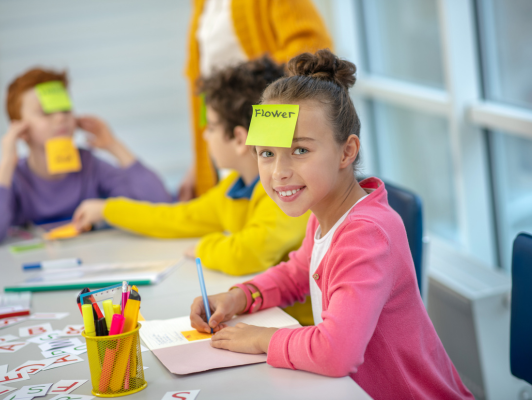
Effective Vocabulary Games and Activities
Educators often integrate games that make the learning process dynamic and engaging to enhance students’ word mastery.
These activities enrich students’ vocabularies and sharpen their recall and application skills in a lively, interactive setting.
Vocabulary Bingo and Jeopardy
Vocabulary Bingo melds the thrill of competition with learning.
Students mark their bingo cards with the correct vocabulary words as definitions or synonyms are called out.
This game enforces not only word recognition but also comprehension.
Adapted from a traditional format, Vocabulary Bingo can be tailored to suit any grade level vocabulary list.
In a similar vein, Vocabulary Jeopardy challenges students to apply their knowledge in a game-show-style format.
Categories can range from word definitions to usage in context, broadening students’ understanding and retention.
Classroom Pictionary and Charades
Transforming vocabulary review into an artful activity, Classroom Pictionary has students illustrate vocabulary words, promoting a deeper connection between the word and its meaning.
As they draw, fellow pupils wager on the intended word, intertwining learning with creativity.
This visual approach often suits visual learners and adds an element of fun to the learning process.
Vocabulary Charades takes a kinetic approach by having students act out words for their classmates to guess.
This activity is especially beneficial for kinesthetic learners and helps anchor word meanings with physicality, making vocabulary recall more instinctive.
Roll-a-Word and Vocabulary Relay
With Roll-a-Word, students cast dice to engage with vocabulary in various ways—defining it, using it in a sentence, or identifying synonyms or antonyms.
This randomness injects an element of surprise into vocabulary practice, ensuring that students remain attentive and invested in the activity.
Vocabulary Relay brings movement into the learning process.
Students race to a board to write sentences incorporating a vocabulary word, fostering quick thinking and teamwork.
The competitive element encourages speed and accuracy, and physical activity aids in memory retention.
Check out the guide below for our list of some of the BEST classroom games to play!
Related: Fun Classroom Games: Engage and Educate with These Ideas

Creative Vocabulary Learning Tools
In today’s classrooms, educators emphasize the importance of enhancing vocabulary through interactive and visual methods.
These tools enrich the students’ understanding of new words and encourage creativity and critical thinking.
Word Walls and Word Maps
Word Walls and Word Maps transform passive learning into an active exploration of language.
A Word Wall is a visual collection of words displayed on a classroom wall, categorically or alphabetically, to enhance a student’s vocabulary knowledge.
Students absorb words and their meanings subconsciously by frequently interacting with the Word Wall.
Word Maps, on the other hand, visually depict the relationship between a word and its features like antonyms, synonyms, and sentences, further cementing its usage and context.
Semantic Maps and Graphic Organizers
Semantic Maps and Graphic Organizers are pivotal in organizing thoughts and relationships between words.
Semantic maps graphically represent the meanings and relations of words, allowing students to see connections and hierarchies.
This encourages deeper understanding as students link words to concepts and categories.
Graphic organizers can vary in complexity, from simple Venn diagrams to intricate flowcharts, which serve to visually represent ideas and definitions, guiding students through the process of integrating new vocabulary into their existing knowledge base.
Frayer Model and Crossword Puzzles
The Frayer Model is a type of graphic organizer tailored for vocabulary acquisition.
It typically consists of a square divided into four sections, where students note a word’s definition, characteristics, examples, and non-examples.
This structured approach aids in comprehensive understanding and retention of words.
Crossword Puzzles blend the challenge of problem-solving with vocabulary practice.
As students fill in the blanks with correct words based on clues provided, they engage in critical thinking and apply their knowledge of sentence formation and word meanings.
Crosswords not only reinforce vocabulary but also make the learning process enjoyable.
Crosswords are just one of many excellent games for learning English.
For a complete guide of the BEST games to learn English, check out the link below!
Related: Best Games to Learn English: Ultimate Guide

Interactive Vocabulary Instruction Strategies
Engaging students effectively in vocabulary learning can be a key factor in language acquisition and comprehension.
These interactive strategies reinforce word knowledge and enhance retention through playful and focused activities.
Tic-Tac-Toe and Concentration Games
Tic-Tac-Toe can be adapted for vocabulary instruction by requiring students to define or correctly use a vocabulary word in order to place their X or O on the game grid.
This method turns a simple game into a powerful tool for reinforcing word meanings and usage.
A classic game of Concentration, also known as Memory, can be played using pairs of vocabulary words and their definitions.
Students flip cards over, trying to find matching pairs, which promotes memorization and recall of vocabulary terms.
Vocabulary Hangman and Word Search
Vocabulary Hangman encourages students to remember the spelling and meaning of words through a process of elimination and strategic guessing.
In a classroom setting, this classic game can be played with a focus on new vocabulary, providing an entertaining way to reinforce word learning.
Similarly, Word Search puzzles serve as a fun way for students to become familiar with the appearance and spelling of new vocabulary.
They must sift through a grid of letters, finding terms from their vocabulary list that can improve their ability to recognize these words in other contexts.
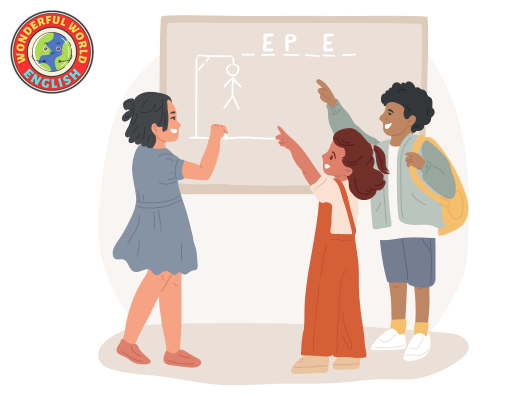
Assessing Vocabulary Progress
Educators implement systematic assessments that measure a student’s command of academic language to ensure effective vocabulary growth.
These assessments not only gauge retention but also help in forming strategies to enhance word comprehension and usage.
Vocabulary Quizzes and Tests
Vocabulary quizzes and tests serve as traditional tools to assess a student’s grasp of vocabulary words.
They may come in various forms, including:
- Multiple-choice questions, where students choose the correct definition or usage of a word.
- Fill in the blanks, encouraging students to select the appropriate vocabulary word to complete a sentence.
Such assessments can highlight the direct relationship between the student’s comprehension of vocabulary and their overall communication skills.
Performance-Based Assessments
Performance-based assessments move beyond written tests to evaluate a student’s practical application of academic vocabulary.
Examples of these might include:
- Students engage in role-plays or debates using specific vocabulary words, which shows the integration of language into communication skills.
- Creating presentations or writing essays that make use of academic and content-specific terms to demonstrate comprehension and success in language mastery.
These methods emphasize the dynamic use of vocabulary as part of expressive language skills, presenting a more holistic view of student assessment.
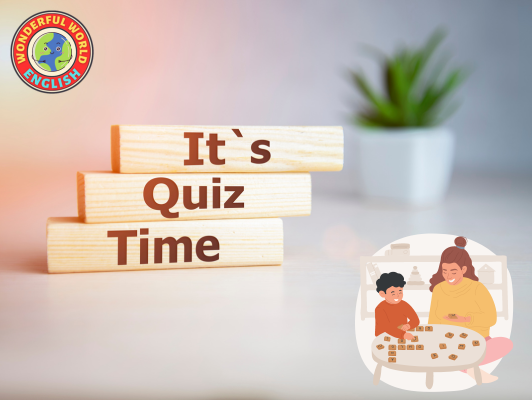
Conclusion
Integrating fun and interactive activities into vocabulary learning transforms it from a mundane task to an engaging adventure, significantly enhancing student engagement and understanding.
Employing a variety of strategies, such as games, creative exercises, and technology-enhanced tools, caters to different learning styles and helps students make meaningful connections with new words.
This approach enriches students’ vocabularies and boosts their ability to apply language in real-life scenarios, improving communication skills across all subject areas.
The shift towards dynamic vocabulary instruction emphasizes active participation, collaboration, and creative expression, fostering a deeper appreciation for the nuances of language.
As educators adopt these innovative methods, they offer students a more rounded and enjoyable learning experience, preparing them for future success in communication.
Ultimately, the move from traditional memorization to engaging vocabulary activities marks a positive evolution in teaching methodologies, setting the stage for lifelong curiosity and growth in language acquisition.
We hope you find value in this guide; you can contact us if you need any assistance.
Have a wonderful day!
Image Attribution: All images licensed via canva.com

